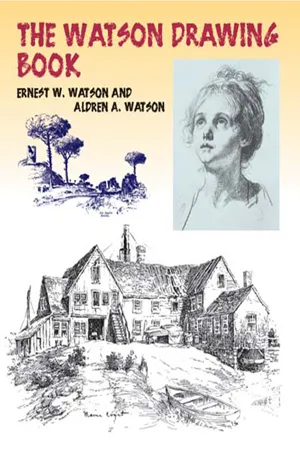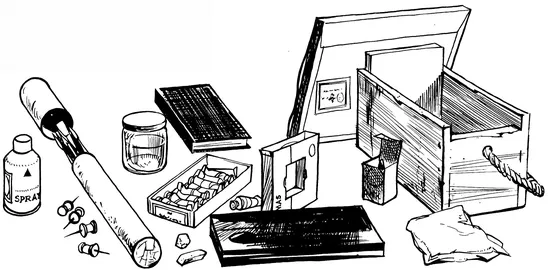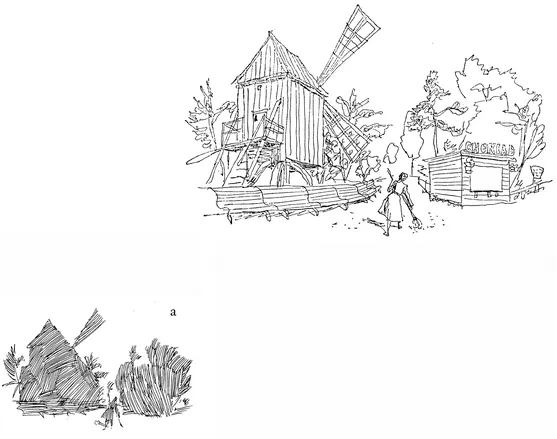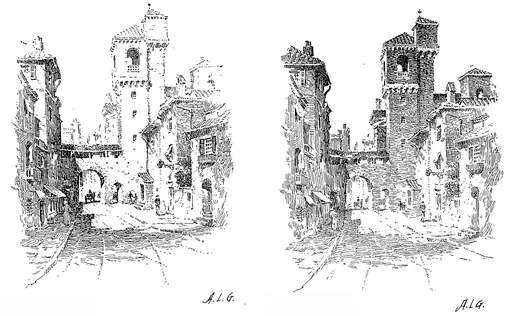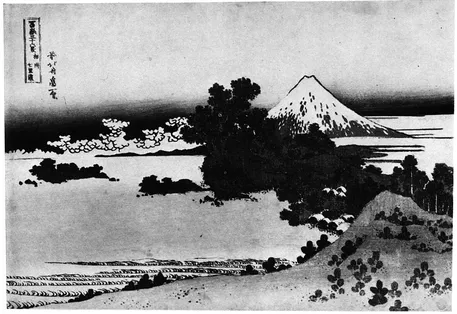![]()
215
Such a complete sketching outfit is fine when traveling by car, but when walking take only the absolute essentials.
XV Outdoor Sketching
Outdoor sketching is one of the most rewarding experiences in the life of an artist. You wake up early on a summer morning, birds are singing; the sun, pink and freshly shining through your bedroom window. It’s going to be a perfect day. What else can you do but make a lunch, pick out a few materials and set out for a day of sketching? Such are the rare moments of life when restrictions, requirements, responsibilities are left behind; when, in short, you are free!
A sketch may be but a few lines picturing your own inner joy. It need not be “finished,” it is not obligated to say anything to anyone else or to sell anything. Even though later you may develop a sketch into a finished picture, now, at the moment, a sketch does not have to be preliminary to anything else. When you are out sketching you are just drinking at the wellspring, not knowing what inspiration and idea may come out of the invigorating draught. This is true whether you be amateur or professional, whether the drawings brought home from a day in the field are competent or incompetent.
In either case they record experiences that are beyond the capacity of the camera. Why is this? When sketching, one becomes a part of the subject, acquires an intimacy with it that cannot be conceived by one who merely points a camera at it. This may be difficult to understand by those who have not had the experience. Sketching is as much a matter of feeling as of seeing—even more. This sense of intimacy is communicated to people who may see your sketchbooks. They will linger longer over them than over an album of snapshots because they are curious to see what you saw. More important of course is what your sketches mean to you: your pictorial diary will enable you to continuously savor the delights of many vacationing days.
216
Pen and ink illustration by Ebbe Sadolin. From Vandringer i Stockholm, Carit-Anderson, Publisher.
The equipment required for black and white sketching is simple, inexpensive, and can conveniently be carried wherever you go. A light metal campstool, one that folds neatly to a flat 8 × 15 inches or so, is almost indispensable, and can be carried under the arm with a portfolio which serves the dual purpose of a drawing board and container for paper. Pencils or other dry sketching tools can be carried in a pocket. A folded newspaper is sometimes useful for those situations when a stone wall or a fallen tree happens to provide the most desirable vantage point.
If you want to be completely prepared technically you may provide yourself with equipment equivalent to that illustrated [FIGURE 215]. This is Aldren’s sketching outfit; that is, when he goes by car. He picked up this box while beachcombing on Cape Cod. It measures 8 × 12 inches and is 8 inches deep. The sea had scrubbed it to a smooth, satin finish. A piece of flotsam rope serves as an adequate handle. The box holds a variety of mediums. It is kept packed, ready for instant use whenever the mood and the opportunity coincide.
Various drawing mediums are discussed in other chapters; here we are to talk about the creative aspects of sketching. Our chapter opened with a rhapsodical reference to the beauties of the morning. Indeed the morning light and atmosphere do seem to be made for the sketcher. But so does the late afternoon when the sun is low in the heavens. A low sun best reveals the beauty of landscape and buildings. The lights and shadows, more dramatic at these times, define forms which fall into attractive patterns that may be entirely absent at noontime. Students are sometimes advised to make several sketches of the same subjects at intervals throughout a day to become conscious of these factors. Those who have lived in coastal towns, where fog often spreads its mantle over fishing wharves and buildings, have an unusual opportunity to witness the drama of light. At an early hour all objects appear as silhouettes, more or less flat masses, all details obscured by the heavy mists. As the sun burns the fog away, forms emerge. Patterns of light and shadow become distinct and details finally appear to complete a picture which one may be tempted to render with a pencil. Naturally some may be more intrigued by the foggy effects. In that event the medium is more likely to be brush or charcoal.
217
A preliminary study for a watercolor, to experiment with light and shadow pattern.
Thus we are reminded that these three aspects of subjects—silhouette, light and shadow, and detail are factors to be considered in almost every outdoor subject. Your drawing might well depend upon the collaboration of all three. Even when the motive principally depends upon light-and-shadow pattern, some parts of it can probably be effectively treated in mass silhouette. By silhouette we mean the over-all shape and character of any form. The dictionary definition of the word is “a representation of an object filled-in with some uniform color.” The verb form uses the expression “to project upon a background like a silhouette.”
We are concerned with both interpretations. Turn to Chapter XVI, where a number of trees are rendered in a single flat tone, unbroken except for holes in the foliage. The shapes of those holes are as decisive as the dark mass itself. Norman Kent, in his ink-rendered landscape [CHAPTER X, FIGURE 142] employed the flat silhouette with fine effect. In one of the two sketches by Arthur L. Guptill [FIGURE 218] we see an example of “forms projected upon a background like a silhouette”; although the darkened buildings are rendered with light and shade, the values are so close that they do not destroy the silhouette effect. In the other sketch, Guptill employed silhouette on the left side as a frame or foil for the tower group that is drawn in delicate line on the other side. In Herbert Kates’ pen sketch [FIGURE 229] we see a somewhat similar silhouetting of buildings on the shaded side of the street as a frame for the light-and-shade treatment on the sunlit side. This sketch deserves study; the rendering of the cluttered façades with their fluttering clothesline is a masterpiece of economical suggestion. One way or another the artist is always aware of the importance of silhouette. Even in such a delicate line technique as Sadolin’s sketch [FIGURE 216] we are reminded, by the filling-in of the envelope that encloses it (a), of the well-designed silhouette of the over-all mass.
218
Pen sketches by Arthur L. Guptill, 1891-1956, American. A European subject showing two compositional treatments of the same subject. From his Drawing With Pen and Ink, Van Nostrand Reinhold.
Thus the concept of “projecting upon a background like a silhouette” is a fairly constant factor in the creative artist’s approach. From the start his picture or sketch is planned with reference to a containing envelope that unifies all the detail which is to go within it. It is possible that in Gordon Grant’s pen sketch at Falmouth, Maine [FIGURE 213], the contour of roof lines (that is, the outline of the envelope) is actually as he presented it, but it is more likely that he redesigned it a bit to conform to an even more interesting silhouette projection. He would feel free to do so.
219
View of Fuji from Seven-Ri Beach, by Hokusai, Japanese, 1760-1849. The Metropolitan Museum of Art, Rogers Fund, 1914.
220
Rocks on Long Island Shore, by E. W. Watson. A preliminary pencil analysis of the basic light and shadow pattern, and below, the finished pencil rendering. From Course in Pencil Drawing, Book I, Reinhold Publishing Corporation.
Silhouette pattern often appears in the picture’s interior rather than as an envelope enclosing it. We see this in Hokusai’s “View of Fuji” [FIGURE 219]. The orientals are notably pattern conscious; they like to compose in relatively flat masses. Their pictures are contrived as artfully as a poem: their artists seem congenitally incapable of the more casual ...
